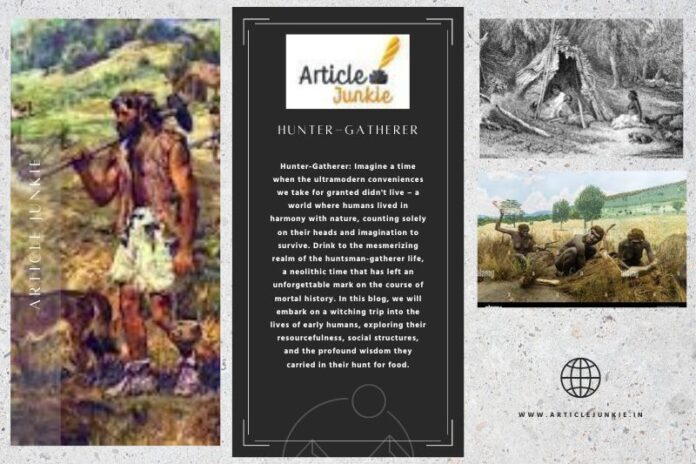Introduction:
Hunter-Gatherer: Imagine a time when the ultramodern conveniences we take for granted didn’t live – a world where humans lived in harmony with nature, counting solely on their heads and imagination to survive. Drink to the mesmerizing realm of the huntsman-gatherer life, a neolithic time that has left an unforgettable mark on the course of mortal history. In this blog, we will embark on a witching trip into the lives of early humans, exploring their resourcefulness, social structures, and the profound wisdom they carried in their hunt for food.
What’s the Hunter-Gatherer Lifestyle?
Question: What Exactly Does the Term “Huntsman-Gatherer” Mean?
Answer: The huntsman-gatherer life refers to a way of life espoused by early mortal societies during the Paleolithic Age. It involved hunting wild creatures for meat and gathering comestible shops, fruits, nuts, and seeds for food.
How Did Hunter-Gatherers Survive in the Wild?
Question: Without Ultramodern Amenities, How Did Huntsman-Gatherers Survive in Harsh Nature?
Answer: Hunter-gatherers reckoned on their deep knowledge of their surroundings to identify comestible shops, detect water sources, and quest creatures using rudimentary tools, similar to pikestaffs, curvatures and arrows, and traps.
What part Did Gender Play in Hunter-Gatherer Societies?
Question: Did Both Men and Women Share in Stalking and Gathering Conditioning?
Answer: Yes, in numerous huntsman-gatherer societies, both men and women played vital places. While men frequently engaged in stalking, women contributed significantly to gathering comestible shops and nurturing their communities.
The Social Structure of Hunter-Gatherer Communities
Question: What was the Social Structure Like within These Ancient Communities?
Answer: Hunter-gatherer societies were generally small, near-knit groups, where cooperation and sharing were essential for survival. Leadership was frequently grounded on knowledge, chops, and experience rather than hierarchical authority.
The Art of Rustling Gathering Comestible shops
Question: How did Huntsman-Gatherers Identify Comestible Shops in the Wild?
Answer: Over generations of observation and trial, early humans learned to identify comestible shops through trial and error, passing down this inestimable knowledge through oral tradition.
Unraveling the Hunt Strategies of Neolithic Bloodsuckers
Question: How did Huntsman-Gatherers Quest for Wild Creatures without Ultramodern Tools?
Answer: Early humans used their knowledge of beast geste and terrain to track and ambush their prey. Their stalking tools, similar to pikestaffs and shells, were designed for effective stalking.
Vagrant Life Following the Seasonal Bounty
Question: Did Huntsman-Gatherer Communities have Endless Agreements?
Answer: utmost huntsman-gatherer groups led a vagrant life, moving with the seasons to follow the vacuity of food coffers. This mobility allowed them to sustain a balanced diet throughout the time.
The Church of Early Humans
Question: Did Huntsman-Gatherer Societies have Religious Beliefs?
Answer: numerous huntsman-gatherer communities held spiritual beliefs, frequently tied to their deep connection with nature. They believed in animism, the notion that all living effects retain a spiritual substance.
The Heritage of Hunter-Gatherer Lifestyle
Question: What impact did the huntsman-gatherer life have on ultramodern societies?
Answer: The huntsman-gatherer life served as the foundational stage of mortal elaboration, contributing to the development of essential survival chops, social structures, and artistic practices that still reverberate in our lives moment.
Conclusion
The huntsman-gatherer life, a phenomenon of mortal adaption and adaptability, provides us with a window into the remarkable trip of our early ancestors. Their profound understanding of the natural world, the complications of rustling, and the art of stalking have left a dateless heritage. As we reflect on their sustainable and harmonious concurrence with nature, we’re reminded of the essential assignments we can learn from our ancient history.
The huntsman-gatherer life inspires us to embrace a more profound connection with the terrain and value the wisdom of our ancestors who navigated the challenges of survival with resourcefulness and continuity. As we recognize their heritage, we’re invited to review our ultramodern actuality and seek harmony with nature, icing a sustainable future for generations to come. The ancient wisdom of the huntsman-gatherer life continues to reverberate, reminding us of the dateless verification that we, as humans, are a thick part of the great shade of life on Earth.

